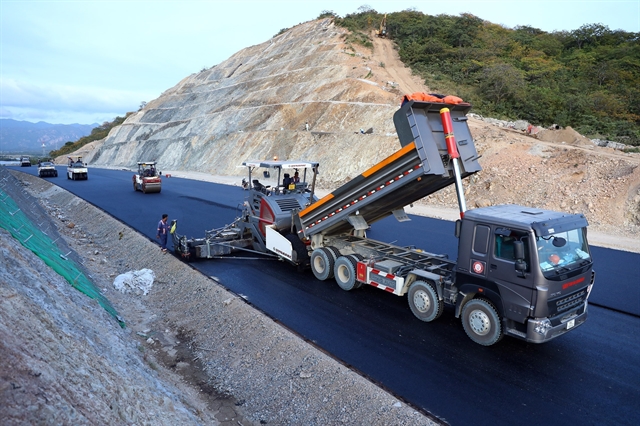 Society
Society

The region has a total of about 120 million cubic metres of sand while the demand for four ongoing expressway projects is 53.68 million cubic metres.

|
| Construction work on the Vĩnh Hảo-Phan Thiết section in Bình Thuận southern province, which is part of the North-South Expressway project. — VNA/VNS Photo Huy Hùng |
HÀ NỘI — Deputy Minister of Natural Resources and Environment, Trần Quý Kiên, believes that if sand reserves in the Cửu Long (Mekong) Delta are exploited and coordinated properly, there would be enough to supply highway projects in the area.
With 60 licensed sand mining projects, the total amount of sand in the region is approximately 80 million cubic meters. Among these, 63 million cubic meters are backfilling sand, and 17 million cubic meters are construction sand.
Recently, provinces in the Mekong Delta have issued 30 exploration licenses, which are expected to provide 39 million cubic meters of backfilling sand and three million cubic meters of construction sand.
The region has a total of about 120 million cubic meters of sand, while the demand for four ongoing expressway projects is 53.68 million cubic meters.
Kiên clarified that this does not mean exploiting all of the above sand at once but spreading it out over four years.
In 2024, a substantial amount of sand will be needed, but the demand will gradually decrease, with the project ending in 2026.
“Rivers in the Mekong Delta have accumulated sediment over many years. They contain a significant amount of clean sand at great depths," Kiên said, adding that this sand could be exploited to serve socio-economic development projects.
Speaking at a conference on highway projects in the Mekong Delta, which was held in Cần Thơ City last Tuesday, Deputy Prime Minister Trần Hồng Hà stated that sand materials posed a significant challenge. Thus, it was essential to anticipate risks associated with excessive river sand exploitation.
The Deputy PM requested the Ministry of Transport and contractors to review the progress of sand supply for projects, ensuring an accurate assessment of the situation. This information should then be submitted to the Ministry of Natural Resources and Environment for coordination and allocation of material sources.
A report by the Ministry of Agriculture and Rural Development, compiled from data collected from various localities, reveals that from 2016 to the present, provinces and cities in the Mekong Delta region have experienced a total of 779 landslides with a combined length of 1,134 kilometres.
Nguyễn Hữu Thiện, an independent researcher specialising in the ecology of the Mekong Delta, emphasised that the shortage of mud and sand was the primary cause of this situation.
He noted that riverbank and coastal erosion were widespread issues in the Mekong Delta today.
"In the early 1990s, when hydroelectric dams were constructed in the Mekong basin, the inflow of sand and sediment into the Mekong Delta began to decrease, leading to an increase in landslides," explained Thiện.
"Subsequently, an increasing number of hydroelectric dams and frantic sand mining activities began occurring in all countries along the Mekong River. As a result, the quantity of sand and mud has significantly decreased, leading to even more frequent and severe landslides."
Research conducted by the Sustainable Sand Management in the Mekong Delta Project, managed by the World Wildlife Fund (WWF) in Việt Nam, at the end of last year, revealed that the current volume of sand flowing into the delta ranges from 6.18 to 7 million tons per year.
Simultaneously, the amount of sand extracted from rivers in this area totals between 28 and 40 million tons per year.
Hà Huy Anh, WWF’s project manager, pointed out that this means the Mekong Delta experiences a yearly sand deficit of 27.5 to 39.5 million tonnes.
Unsustainable sand mining is significantly affecting the morphology of the two main rivers in the Mekong Delta region, the Tiền and Hậu rivers, he emphasised. — VNS